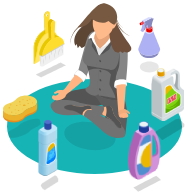
Eradicating Bed Bugs: Bed Bug Treatment that Works!
Bed bugs are small, wingless insects which often live on bedding and furniture, but can also be found under loose wallpaper, on clothing, mattresses, and furnishings. Around the bed, they can be found in the cracks of the frame and headboard, generally fitting into any sized gap capable of holding the width of a credit card, making them one of the toughest cleaning challenges to deal with. They feed exclusively on warm-blooded animals and people but are called bed bugs due to their preference for human hosts and habitats, generally feeding on exposed skin while their hosts are asleep.
When disturbed, they often seek shelter in dark, hidden locations. Whilst bed bugs do not usually cause health problems beyond itchy bites, they are considered to be a growing issue in a variety of dwellings and can negatively impact your business. Eliminating bed bugs can be challenging, although not impossible if certain steps are taken.
Eradicating bed bugs is not as simple as a single task that will see them go forever as they are notoriously hard to clean. For bed bug treatment to be effective, a number of steps must be followed.
Stay Connected
Want to hear more from The Cleaning Collective? Sign up to our mailing list for the latest offers and news

Confirm You Have Bed Bugs
Before you start the elimination process, it’s critical to make sure you truly have a bed bug infestation rather than another type of pest, like fleas. Indications may include blood on your sheets and pillowcases, a musty odour and leftover items like shed skins, faecal matter or eggs. In many cases, you may have to spot the bugs themselves. They’re small — about five millimetres — flat, brown, and oval-shaped. Use a torch and magnifying glass if necessary.
Tidy Up Clutter and Vacuum
Once you’ve discovered that you have an infestation and have narrowed down where it has taken place (usually in the bedroom), it’s time to start cleaning. Pay close attention to kids beds with storage, it may look cosy and organised but there could be critters lurking!
You’ll want to remove all clutter from the affected area, but don’t remove it from the room if it belongs somewhere else. If you do have to take it from the room, seal it in a plastic bag. Once you have all the clutter picked up, take your vacuum cleaner, and go over every inch of the room, including your electronics, mattress, walls, floors, carpet and even your dresser drawers. Dump the contents of the vacuum cleaner into a plastic bag, and seal it up before disposing of it in an outdoor dustbin.
Pay Attention to Linens
Next, fabric items will need to be removed from the affected area and placed in a sealed plastic bag. This includes sheets, blankets, curtains, pet bedding, pillowcases, and anything else you may have in the room.
The linens should be washed at the highest possible temperature setting on your machine. Research has shown that exposing bed bugs to temperatures in excess of 45 degrees Celsius for an hour will kill them, and the NHS recommends washing affected linens on at least 60 degrees Celsius.
Linens that cannot be washed should be put in a hot clothes drier for at least 30 minutes. Whilst you're at it, add some dryer sheets to gas them out even more and get your laundry smelling fresh, Bulkier items that cannot be treated, such as your mattress, furniture and bulky bedding may need to be thrown away, although professional heat treatment has also shown to be effective. Bed bugs can live for long periods of time without a food source, so attempting to starve them may not be adequate, although you could try sealing these items for up to a year. Replacing the items, however, is likely to be more effective.
Get Rid of Bed Bug Hiding Spots
To prevent a recurrence of a bed bug infestation, it’s important to eliminate their chosen hiding places from the room.
Keep the area clutter free, move your bed away from the walls and seal up cracks in the walls, flooring, or furniture. Fix any loose wallpaper. Open drawers, take the bed frame apart and move furniture to scrub and re-vacuum every inch of the room.
If you are unable to change your mattress, scrub it with a hard-bristle brush, and seal it with a bed bug-proof cover (similar to those used for dust mite control). It traps any bugs you missed inside the cover, and it will prevent new ones from getting into your mattress. Don’t remove the cover for at least a year.
Monitor the Contaminated Area
After you’ve cleaned everything in the contaminated area, it will be important to continue to closely monitor. At the first sign of bed bugs reoccurring, it may be necessary to resort to other measures to remove them.
You can purchase great products such as insecticides (Bio Productions Insecticide) and HD Pressure Sprayers with Lances to kill them.
Looking to purchase cleaning supplies? You can buy cleaning products for your home , or even commercial cleaning supplies for your business.
Stay Connected
Stay connected and be the first to know about our latest products, special offers, and exciting news:The Cleaning Blog
Want to learn more about cleaning? From the latest cleaning and hygiene news to handy how-to guides, why not check out our most popular blog categories.Stay Connected
Stay connected and be the first to know about our latest products, special offers, and exciting news:











